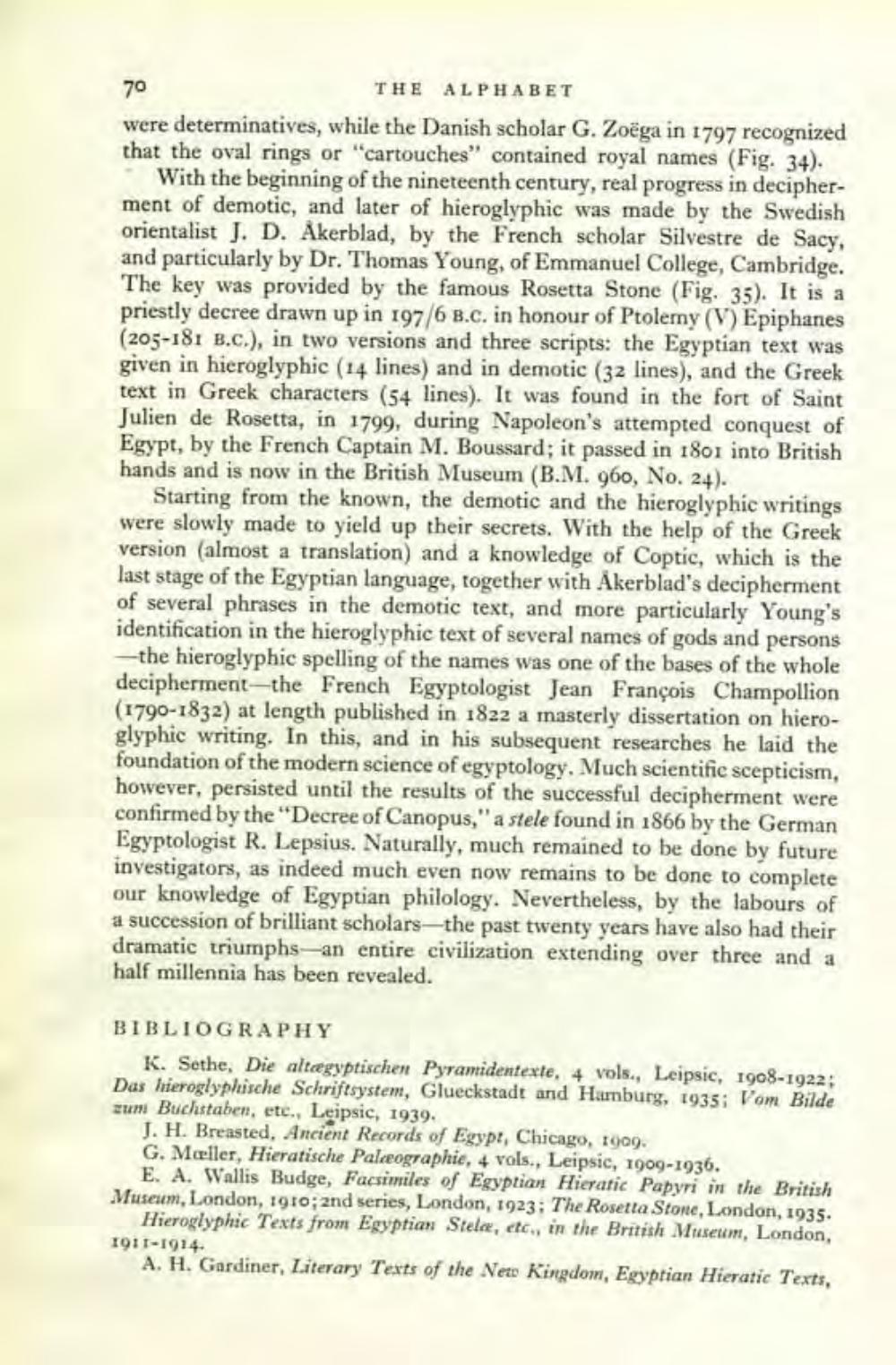________________
70
THE ALPHABET were determinatives, while the Danish scholar G. Zoëga in 1797 recognized that the oval rings or "cartouches" contained royal names (Fig. 34).
With the beginning of the nineteenth century, real progress in decipherment of demotic, and later of hieroglyphic was made by the Swedish orientalist J. D. Åkerblad, by the French scholar Silvestre de Sacy, and particularly by Dr. Thomas Young, of Emmanuel College, Cambridge. The key was provided by the famous Rosetta Stone (Fig. 35). It is a priestly decree drawn up in 1976 B.c. in honour of Ptolemy (V) Epiphanes (205-181 B.c.), in two versions and three scripts: the Egyptian text was given in hieroglyphic (14 lines) and in demotic (32 lines), and the Greek text in Greek characters (54 lines). It was found in the fort of Saint Julien de Rosetta, in 1799, during Napoleon's attempted conquest Egypt, by the French Captain M. Boussard; it passed in 1801 into British hands and is now in the British Museum (B.M. 960, No. 24).
Starting from the known, the demotic and the hieroglyphic writings were slowly made to yield up their secrets. With the help of the Greek version (almost a translation) and a knowledge of Coptic, which is the last stage of the Egyptian language, together with Akerblad's decipherment of several phrases in the demotic text, and more particularly Young's identification in the hieroglyphic text of several names of gods and persons -the hieroglyphic spelling of the names was one of the bases of the whole decipherment--the French Egyptologist Jean François Champollion (1790-1832) at length published in 1822 a masterly dissertation on hjeroglyphic writing. In this, and in his subsequent researches he laid the
ation of the modern science of egyptology, Much scientific scepticism however, persisted until the results of the successful decipherment were confirmed by the "Decree of Canopus," a stele found in 1866 by the German Egyptologist R. Lepsius. Naturally, much remained to be done by future investigators, as indeed much even now remains to be done to complete our knowledge of Egyptian philology. Nevertheless, by the labours of a succession of brilliant scholars--the past twenty years have also had their dramatic triumphs-an entire civilization extending over three and a half millennia has been revealed.
BIBLIOGRAPHY
K. Sethe, Die altægyptischen Pyramidentexte, 4 vols., Leipsic, 1908-1922; Das hieroglyphische Schriftsystem, Glueckstadt and Hamburg, 1935; Vom Bilde zumi Buchstaben, etc., Leipsic, 1939.
J. H. Breasted, Ancient Records of Egypt, Chicago, gog. G. Mæller, Hieratische Palceographie, 4 vols., Leipsic, 1909-1936.
E. A. Wallis Budge, Facsimiles of Egyptian Hieratic Papyri in the British Museum, London, 19to;2nd series, London, 1923: The Rosetta Stone, London, 1935.
Hieroglyphic Texts from Egyptian Stela, etc., in the British Museum, London, 1911-1914.
A. H. Gardiner, Literary Texts of the Neto Kingdom, Egyptian Hieratic Texts,




